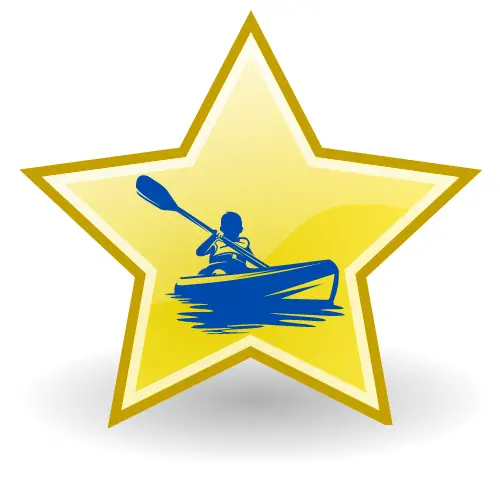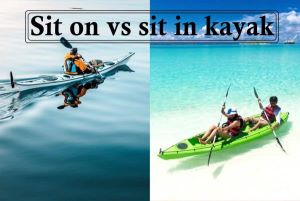There are two types of kayaks: Sit-on-Top (SOT) and Sit-Inside (SIS) kayaks, and both are available as singles or tandems. Some may be confused about choosing one of these from not knowing that they can also be still solid and inflatable. Each of them has its own advantages and disadvantages which I want to tell you in my article.
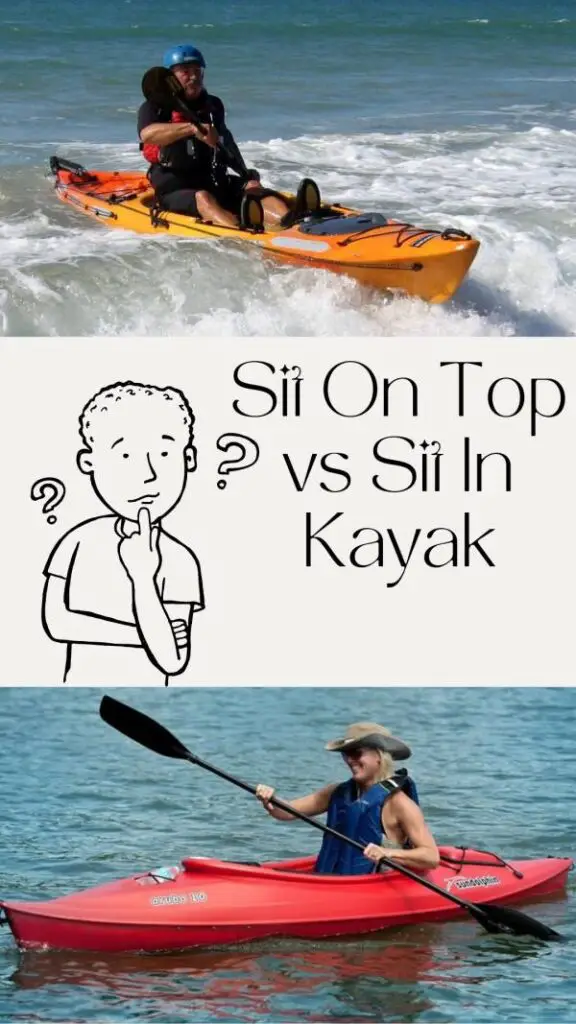
What is better: a sit-in kayak or a sit-on-top kayak? Sit inside kayaks are better for rough or cold water, and when you don’t want to get wet. Sit-on-top kayaks are better for beginners, summer fun, and general recreational purposes. Sit inside kayaks are ideal for surfing, touring, and paddling long distances. A sit-on kayak is more suitable for learning, cooling down, and getting in and outside of your kayak.
If you are purchasing your first kayak when choosing, you need to consider the differences in each option. This article will help you determine which style of kayak is best for you if you are new to the business.
Table of Contents
Differences Between Sit-on-top and Sit-in Kayaks
There are some significant differences between these boats with the sit and top, they have many parts in common. The top of the kayak is called the deck, the bottom is the hull, the front is the bow, and the back is the stern. On top of the deck, you will often have deck lines or bungees.
But the main difference between these two types of kayaks is that the seating is enclosed. There is an area called the cockpit where you sit, and around the cockpit is a cockpit rim to which you can attach a splash guard for water protection. In the cockpit, you will find a seat and pedals that can be adjusted to the length of your legs, if they are present there.
Benefits and Drawbacks of Sit-In Kayak
A sit-in kayak is self-explanatory. This particular kayak’s structure allows you to place your lower body in the cockpit. This may sound like the best option for beginners because it gives you extra security. But, it could be exactly the opposite.
Although it is true that a sit-in kayak serves the purpose of protecting your lower body from the water and cold winds, making it ideal for kayaking in cold water, there are safety considerations.
Benefits: - Lower in the water, you have a lower center gravity; - They glide faster through the water; - They can help keep your lower extremities dry with the right cockpit cover; - These kayaks are generally lighter than Si-on-tops and easier to transport.
This is a recreational sit-inside kayak, so you may feel restricted. The tight cockpit makes it difficult to maneuver while paddling. A sit-in kayak has one disadvantage: if you accidentally capsize in the water, your kayak will become plugged and make it difficult to paddle. You may also get wet and capsize.
You will need to drain the water from the cockpit before you can go on or return to shore. This is something that more experienced kayakers can do. You should at least know how to do this and practice it before you venture too far from shore in a sit-in boat.
It is also more difficult to get in and out of a sit-in, vs sit-on-top kayak if you are in open water.
Drawbacks: - It is more difficult to get them in and out of the cockpit; - If they capsize, they can fill up with water; - It is harder to get back in after falling in open water.
The most popular models of Sit-In kayaks according to buyers






Last update on 2024-04-20 / Affiliate links / Images from Amazon Product Advertising API
Benefits and drawbacks of Sit On Top Kayaks
Sit-on-top kayaks are different than sitting on top kayaks. They may be better for beginners or people who need more space to learn how to kayak. Sit on top vs don’t have a cockpit to protect your lower body. You can sit on the kayak with a molded-in seat and footrest.
Sit-on-top kayaks are great for beginners, nervous paddlers, and those who are just starting out in kayaking.
Benefits: - Easier to get in and out of; - Made of stronger materials; - Easier to learn; - Easier to climb back in if you flip over; - They don't fill with water if they sink.
Sit-on kayaks are great for beginners as they allow them more freedom and help them stay balanced. These scupper holes allow water to enter the kayak’s top and flow back through the scupper hole. This prevents water from filling the kayak.
A downside to sitting on kayaks is the lack of sheltered space. You’ll get wet while you kayak and paddle. If you don’t like the idea of getting wet you might consider a recreational sit-in kayak with a wider cockpit opening.
Drawbacks: - Heavy Sit-on-top kayaks; - You will get wet; - It takes more energy to paddle them; - Your center of gravity is higher, making you “tippy”.
Is it better to Sit-in or Sit-on?
Which one is better, a sit-in kayak or a sit-on kayak?
It all depends on your situation, your level of experience, and where and how you plan to kayak.
The sit-in kayak is better for intermediate and advanced kayakers who are more likely to be in cold water. If you are a beginner or not comfortable paddling a kayak by yourself, then a sit on top might be better.
Your kayaking experience will determine the best kayak choice. Here are some options based on the most common kayaking needs.
Sit-on-top kayaks are more suitable for:
- Summertime fun.
- Warm weather.
- Learning.
- Children.
- You shouldn’t be rough with your kayak. Rotomolded sit-on-top kayaks can withstand more abuse.
- You don’t want to get trapped in the cockpit, but you should be if you do capsize.
- Fishing kayaks!
Sit-inside kayaks work better for:
- Water and cold weather.
- Long-distance touring.
- Ocean touring.
- Surf kayaking.
- River kayaking, both long-distance, and whitewater.
- Racing.
- Drying out.
There are differences between Sit-In Kayaks and Sit On Top Kayaks
There is no significant difference in their physical characteristics. The only thing that will make a difference in your comfort level and body positioning. These kayaks work best in certain water conditions, so it is important to consider these factors when selecting a kayak.
Sit-In or Standing? Sit-In vs.
Sit-in kayaks are the most traditional type of kayak. Kayaking history dates back thousands of years when these types of kayaks were used by paddlers to make their way across arctic waters for hunting. Sit-in kayaks were transformed over time for recreational use.
A sit-in kayak can be small but you have plenty of storage space. This kayak is smaller than a sit-on-top and is ideal for day paddling or short expeditions.
Sit-on kayaks may not be as well-suited for long expeditions but are great for short trips.
Sit-on-top kayaks are for people who want to have fun on the water. Sit-on, especially for beginners, is the best kayak, especially if you’re kayaking with kids.
The best thing about a sit-on-top kayak is its ability to rescue itself. The sit-on kayak is a different type of kayak. Instead of being in the kayak, you can immediately get out of the kayak if it capsizes.
This makes it possible to quickly and easily rescue yourself if the kayak flips.
For beginners, sit-in or sit on top kayaks
There isn’t much difference between sit-in and sit-on kayaks when it comes to novice kayakers learning to kayak. Before you go on your first kayaking adventure, it’s important to consult with a professional for any type of kayak.
For beginners, it is important to be aware of the safety requirements and preparation required for kayaking.
These tips are helpful for all types of kayakers.
- Don’t dress for the weather, but for the water. The water in which you will be kayaking may dictate the type of kayak you choose. A sit-in kayak is typically used in cold water, so it’s important to be prepared for this. A wetsuit will suffice in this situation. A swimsuit will be sufficient if you are kayaking in warmer water.
- Learn safety skills. Safety protocols must be followed for any high-intensity activity or sport, particularly if there’s water involved. Safety protocols are important for kayakers of all types. Kayaks can flip in water and could cause serious injury.
- Get familiar with the different styles of paddling. It is important to be familiar with the basics of paddling before you take your kayak out on the water. Before you put your kayak on the water, practice paddling strokes while your kayak is still on the ground. You can find many YouTube videos to help you do this exercise. You must know at least four strokes: the forward stroke (reverse stroke), sweep stroke, draw stroke, and sweep stroke.
- You can adjust your kayak when you are on dry ground. This is only for sit-in kayaks. You can adjust the kayak seat to your liking if it is adjustable or has footrest pegs. Avoid doing this on the water. If you move too much on your kayak, it will likely tip over.
- Be sure to have a pleasant experience your first time. You want your first kayaking experience to be as safe and enjoyable as possible, regardless of whether you’re in a sit-in or a sit-on. Your first kayak trip should take place in calm waters. You will be more comfortable kayaking in calm waters if you decide to venture out into rougher water.
- Don’t go kayaking solo! The only thing you can take away from this article is that you shouldn’t go kayaking solo no matter how much you know, it is important to be there for others. Accidents happen. You should always have someone to help you in case of one.
You can see that there is no significant difference in a beginner’s experience using a sit-in kayak or a sit-on-top kayak. These tips will help you remember that training and preparation are important. You don’t want to risk your life or the safety of your family by not being prepared.
The most popular models of Sit-On-Top kayaks according to buyers
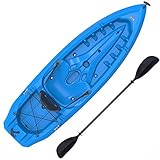





Last update on 2024-04-20 / Affiliate links / Images from Amazon Product Advertising API
These kayaks are great for beginners. They will help you to understand what to look out for when buying a kayak. You should research all options before you decide to buy one. These are just three of the many options available that best fit your needs.
Fishing: Sit-In, Sit-On-Top Kayaks
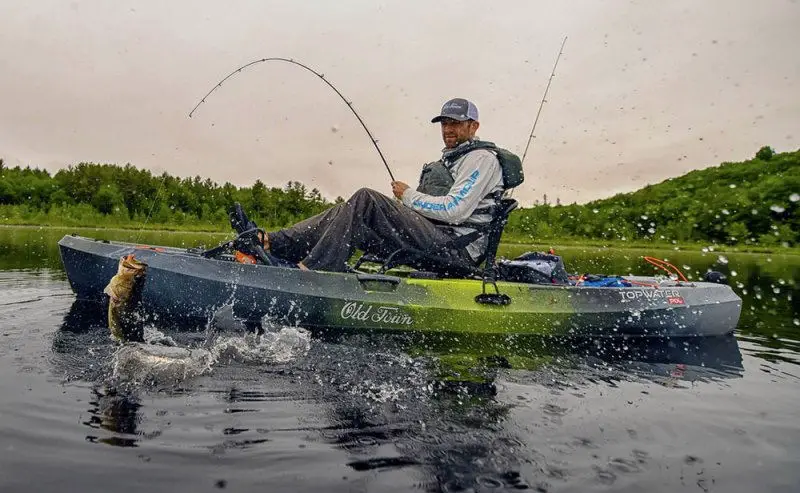
Kayaking is a great way to go fishing kayak. However, fishing from a kayak is quite different from fishing from an enclosed boat.
Before you go kayak, there are a few things to remember.
Sit-In Kayak Fishing
Sit-in kayaks are great for fishing in colder months as they protect your lower body from the colder water. A cockpit makes it easier to store your fishing gear. You can store all your fishing gear comfortably without having to figure out where it is.
Sit-in kayaks are best for experienced fishermen, as they can be more tippy than their counterparts.
Sit-On-Top Kayaks for Fishing
For beginners, the sit-on-top kayak is more suitable for fishing.
This kayak offers something that a sit-in cannot: it allows you to stand while fishing. That’s how many fishermen fish from a boat or a dock. The sit-on kayak also has more space at the top which makes it easier to attach your gear.
Special fishing kayaks are made larger, wider, and more stable. They are made for standing up and fishing from them.
Both kayaks have their advantages when it comes to fishing. In fact, they are much cheaper than renting a boat. Sit on kayaks might be the best choice if you are just starting kayak fishing.
Sit on vs Sit in kayak summary
Which kayak is best? Both kayak designs are excellent for the purpose they were intended.
It is important to know your level of comfort. It is important to know the basics of what you are doing, especially if it involves something that could put your life in danger.
What can you learn from this? A sit-on kayak is a good choice for beginners. You can then use it as a practice paddle and get used to the inside. It is easier to learn the basics of paddling from a sit-on. Sit-ins are more comfortable than sit-ins.
You might consider upgrading to a sit-in kayak’s cockpit if you are looking to go on full-day trips or tour big waterways. Sit-inside will allow you to paddle further and faster.
Remember to keep safe and to take it slow while you improve your paddle skills.
FAQ
Which is better, a kayak or a sit-on?
Sit-on-top kayaks are better for paddling farther from shore and on the ocean. They are lightweight and easy to climb on if you get swept away. Many sit-inside recreational kayaks have large cockpits with limited floatation.
What are the benefits of a sit-on-top kayak?
Sit-on-top kayaks are made of polyethylene and have a strong beam for stability. They also often have self-bailing holes that allow water to drain into the cockpit. These boats are great for recreational paddling in lakes and slow-moving rivers as well as protected coastal waters.
Are our sit-on-top kayaks suitable for rivers?
Sit-on-top kayaks can be used as fishing platforms. They also allow for freedom of movement that sits in kayaks don’t. However, Sit-on tops have their limitations, especially as the currents become stronger and the water becomes rougher.
Can a kayak with a seat in it sink?
Simply put, yes. A kayak could sink. A kayak can sink if it has a seat inside. If you don’t have bulkheads to increase buoyancy, water could enter the cockpit.
Is canoeing harder than kayaking?
Because of the coordination and nuances involved in paddling strokes, canoeing can be more challenging than kayaking. Canoes weigh more than kayaks and require more effort to propel a canoe across the water. It’s also more difficult to maneuver a canoe that is large while maintaining forward momentum.
Our best posts:
